INSTITUT SUPERIEUR D'ANTHROPOLOGIE
INSTITUTE OF ANTHROPOLOGY
ONLINE COURSES / COURS A DISTANCE
INSCRIPTION : Année Universitaire 2012/2013
REGISTRATION : Academic Year 2012 / 2013
TURQUIE – 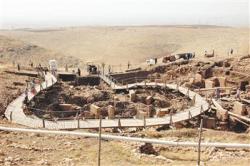 Göbeklitepe - Scientists from Turkey and around the world gathered Oct. 2 in the southeastern province of Şanlıurfa to evaluate new data from recently conducted archaeological excavations at the ancient site of Göbeklitepe, which contains some of the oldest traces of human existence. The head of the Göbeklitepe excavations, archaeologist Professor Klaus Schmidt of the German Archaeology Institute, said they had found many flint stones, animal bones and bird figures holding human heads during this season’s excavations. Schmidt said they had launched new excavation work in September and would continue working until November. “The main purpose of this year’s works is to make research for a roof that will be set up here. After that we will start preparations.” Schmidt said excavations in the region had been continuing for 17 years and that they had encountered objects that had shaped subsequent generations of humans. “Discoveries in the excavation area should be evaluated from many sides. We have gathered very important data and we are making analyses.” Dr. Marion Bena, who is a member of the excavation team at the southeastern province of Diyarbakır’s Kortik Tepe, said the discoveries at Göbeklitete were enough to change the history of human beings, adding that they were very excited to see the results of the analyses. Göbeklitepe is believed by some archaeologists to be the world’s oldest place of worship. The hilltop sanctuary of Göbeklitepe, a temple complex that dates back to Neolithic times, has been added by UNESCO to its tentative list of World Heritage Sites.
Göbeklitepe - Scientists from Turkey and around the world gathered Oct. 2 in the southeastern province of Şanlıurfa to evaluate new data from recently conducted archaeological excavations at the ancient site of Göbeklitepe, which contains some of the oldest traces of human existence. The head of the Göbeklitepe excavations, archaeologist Professor Klaus Schmidt of the German Archaeology Institute, said they had found many flint stones, animal bones and bird figures holding human heads during this season’s excavations. Schmidt said they had launched new excavation work in September and would continue working until November. “The main purpose of this year’s works is to make research for a roof that will be set up here. After that we will start preparations.” Schmidt said excavations in the region had been continuing for 17 years and that they had encountered objects that had shaped subsequent generations of humans. “Discoveries in the excavation area should be evaluated from many sides. We have gathered very important data and we are making analyses.” Dr. Marion Bena, who is a member of the excavation team at the southeastern province of Diyarbakır’s Kortik Tepe, said the discoveries at Göbeklitete were enough to change the history of human beings, adding that they were very excited to see the results of the analyses. Göbeklitepe is believed by some archaeologists to be the world’s oldest place of worship. The hilltop sanctuary of Göbeklitepe, a temple complex that dates back to Neolithic times, has been added by UNESCO to its tentative list of World Heritage Sites.
http://www.hurriyetdailynews.com/academics-gather-to-discuss-gobeklitepe.aspx?pageID=238&nID=31587&NewsCatID=375
USA – 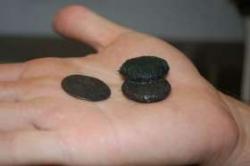 St. Augustine - A corroded uniform button found in the mud off the St. Augustine Beach pier could be the “smoking gun” that leads to identifying a mystery shipwreck. And the copper coin with a face of what could be Britain’s King George found by a Lighthouse Archaeological Maritime Program volunteer just adds to evidence that the wreck could be part of a British Revolutionary War fleet that fled Charleston in 1782. The corroded button bears the number 74. That means it came off a 74th Regiment British Army uniform of Cambell’s Highlanders, assembled in Scotland in 1777 to fight rebels in North America. When the British fled the American army’s advance into Charleston, half the fleet headed into the St. Johns River in Jacksonville and the rest went to St. Augustine. There, 16 of them wrecked on Dec. 31, including the escort ship Rattlesnake, said Chuck Meide, archaeology director at the St. Augustine Lighthouse and Museum program. “This is a smoking gun,” Meide said. “This confirms the ship we are digging on was in the evacuation of Charleston.”
St. Augustine - A corroded uniform button found in the mud off the St. Augustine Beach pier could be the “smoking gun” that leads to identifying a mystery shipwreck. And the copper coin with a face of what could be Britain’s King George found by a Lighthouse Archaeological Maritime Program volunteer just adds to evidence that the wreck could be part of a British Revolutionary War fleet that fled Charleston in 1782. The corroded button bears the number 74. That means it came off a 74th Regiment British Army uniform of Cambell’s Highlanders, assembled in Scotland in 1777 to fight rebels in North America. When the British fled the American army’s advance into Charleston, half the fleet headed into the St. Johns River in Jacksonville and the rest went to St. Augustine. There, 16 of them wrecked on Dec. 31, including the escort ship Rattlesnake, said Chuck Meide, archaeology director at the St. Augustine Lighthouse and Museum program. “This is a smoking gun,” Meide said. “This confirms the ship we are digging on was in the evacuation of Charleston.”
http://jacksonville.com/news/florida/2012-10-03/story/button-found-st-augustine-shipwreck-smoking-gun-its-identity
MEXIQUE – 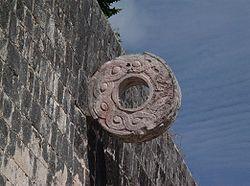 Chichen Itza - Experts in Mexico say they have determined that the ancient Mayas used watchtower-style structures at the temple complex of Chichen Itza to observe the equinoxes and solstices. The bases of the structures were found atop the walls of the long ceremonial court, where a ritual ball game was played. But to determine their use, archaeologists first had to rebuild the small, stone-roofed structures. Each of the structures has a narrow slit running through it. Government archaeologist Jose Huchim says he has found that the sun's rays shine into the slits at the winter solstice, and at another angle on the equinoxes.
Chichen Itza - Experts in Mexico say they have determined that the ancient Mayas used watchtower-style structures at the temple complex of Chichen Itza to observe the equinoxes and solstices. The bases of the structures were found atop the walls of the long ceremonial court, where a ritual ball game was played. But to determine their use, archaeologists first had to rebuild the small, stone-roofed structures. Each of the structures has a narrow slit running through it. Government archaeologist Jose Huchim says he has found that the sun's rays shine into the slits at the winter solstice, and at another angle on the equinoxes.
http://phys.org/news/2012-10-mexico-mayan-ball-court-celestial.html
GRECE – 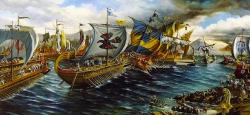 Salamis - Some 2,500 years ago a naval battle took place in September (although the exact date remains unknown) in the straits between the Greek mainland and Salamis, an island in the Saronic Gulf near Athens. The battle of Salamis changed forever the course of history and halted the Persians from advancing to the West after a series of battles with the ancient Greeks.
Salamis - Some 2,500 years ago a naval battle took place in September (although the exact date remains unknown) in the straits between the Greek mainland and Salamis, an island in the Saronic Gulf near Athens. The battle of Salamis changed forever the course of history and halted the Persians from advancing to the West after a series of battles with the ancient Greeks.
http://greece.greekreporter.com/2012/09/28/battle-of-salamis-marked-after-2500-years/
USA – 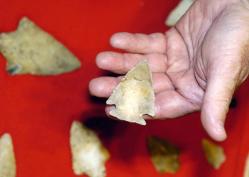 Amerson River Park - A local archaeologist is planning the first major excavation of Creek Indian towns along the Ocmulgee River since digs at the Ocmulgee National Monument mounds during the Depression. The first of three excavations is slated for a popular park within the Macon city limits. Macon native Stephen Hammack, who was long employed as an archaeologist at Robins Air Force Base, was accepted this summer into a doctoral program at Oxford University in England, where he plans to research Creek towns along the Ocmulgee between 1680 and 1716. He said he hopes to start next summer in Amerson River Park, formerly Amerson Water Works Park. NewTown Macon, which owns the park, has already signed off on the project. Europeans recorded Creek town names but not their exact locations. In most cases the town name referred to the band of people who lived there, so the town moved when the people did, Hammack said. He believes the River Park town might have been one called Kasita.
Amerson River Park - A local archaeologist is planning the first major excavation of Creek Indian towns along the Ocmulgee River since digs at the Ocmulgee National Monument mounds during the Depression. The first of three excavations is slated for a popular park within the Macon city limits. Macon native Stephen Hammack, who was long employed as an archaeologist at Robins Air Force Base, was accepted this summer into a doctoral program at Oxford University in England, where he plans to research Creek towns along the Ocmulgee between 1680 and 1716. He said he hopes to start next summer in Amerson River Park, formerly Amerson Water Works Park. NewTown Macon, which owns the park, has already signed off on the project. Europeans recorded Creek town names but not their exact locations. In most cases the town name referred to the band of people who lived there, so the town moved when the people did, Hammack said. He believes the River Park town might have been one called Kasita.
http://www.macon.com/2012/09/29/2195607/excavation-of-indian-town-planned.html